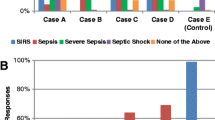Abstract
Purpose
To assess the interobserver agreement on clinical history and physical examination when using a semi-structured questionnaire to evaluate patients with an acute febrile illness (AFI).
Methods
A cross-sectional study was conducted with outpatients aged 12 years and over, presenting with an AFI defined as fever up to 7 days and no evident focus of infection. Clinical data were collected independently by two physicians using a semi-structured questionnaire. Interobserver agreement was estimated using kappa coefficients with a 95% confidence interval (CI).
Results
A total of 140 patients (age range 13–73 years; 56.4% females) were enrolled. All symptoms showed weighted kappa values significantly greater than 0.6, indicating an at least substantial agreement. As most physical signs were infrequent and of mild intensity, they were recoded and analyzed as absent/present. Of the signs with prevalence ≥15%, exanthema, pallor, lymph node enlargement, and eye congestion showed agreements significantly greater than 0.6, while kappa confidence limits for pharyngeal erythema and dehydration included values classified as regular.
Conclusions
High agreement was observed for most of the clinical data assessed, and symptom grading was feasible. Some physical findings were rare and their inclusion in a structured form may not be justified in this setting. The questionnaire application showed good reliability for the most frequent signs and symptoms and may prove to be useful at gathering data for surveillance and research at sentinel sites.

Similar content being viewed by others
References
Dassanayake DL, Wimalaratna H, Agampodi SB, Liyanapathirana VC, Piyarathna TA, Goonapienuwala BL. Evaluation of surveillance case definition in the diagnosis of leptospirosis, using the microscopic agglutination test: a validation study. BMC Infect Dis. 2009;9:48.
Crump JA, Youssef FG, Luby SP, Wasfy MO, Rangel JM, Taalat M, et al. Estimating the incidence of typhoid fever and other febrile illnesses in developing countries. Emerg Infect Dis. 2003;9:539–44.
Gubler DJ. Surveillance for dengue and dengue hemorrhagic fever. Bull Pan Am Health Organ. 1989;23:397–404.
Marzochi KBF. Endemic dengue: surveillance strategy challenges. Rev Soc Bras Med Trop. 2004;37:413–5. doi:10.1590/S0037-86822004000500009.
Archibald LK, Reller LB. Clinical microbiology in developing countries. Emerg Infect Dis. 2001;7:302–5.
Peat G, Wood L, Wilkie R, Thomas E. How reliable is structured clinical history-taking in older adults with knee problems? Inter- and intraobserver variability of the KNE-SCI. J Clin Epidemiol. 2003;56:1030–7. doi:10.1016/S0895-4356(03)00204-X.
Manterola C, Muñoz S, Grande L, Bustos L. Initial validation of a questionnaire for detecting gastroesophageal reflux disease in epidemiological settings. J Clin Epidemiol. 2002;55:1041–5. doi:10.1016/S0895-4356(02)00454-7.
Bossuyt PM, Reitsma JB, Bruns DE, Gatsonis CA, Glasziou PP, Irwig LM, et al. Towards complete and accurate reporting of studies of diagnostic accuracy: the STARD initiative. Fam Pract. 2004;21:4–10.
Margolis P, Gadomski A. The rational clinical examination. Does this infant have pneumonia? JAMA. 1998;279:308–13. doi:10.1001/jama.279.4.308.
Streiner DL, Norman GR. Health measurement scales: a practical guide to their development and use. 2nd ed. Oxford: Oxford University Press; 1995.
Porto CC. Semiologia médica. 5th ed. Rio de Janeiro: Guanabara Koogan; 2005.
Schechter M, Marangoni DV. Doenças infecciosas: conduta diagnóstica e terapêutica. 2nd ed. Rio de Janeiro: Guanabara Koogan; 1998.
Kasper DL, Braunwald E, Hauser S, Longo DL, Jameson JL, Fauci AS. Harrison’s principles of internal medicine. 16th ed. New York: McGraw-Hill Medical Publishing Division; 2005.
Lauritsen JM, Bruus M. EpiData (version 3). A comprehensive tool for validated entry and documentation of data. Odense, Denmark: The EpiData Association; 2003–2004.
StataCorp. Stata Statistical Software: Release 9. College Station, TX: StataCorp LP; 2005.
Cohen J. A coefficient of agreement for nominal scales. Educ Psychol Meas. 1960;20:37–46.
Fleiss JL. Statistical methods for rates and proportions. 2nd ed. New York: Wiley; 1981.
Reichenheim ME. Confidence intervals for the kappa statistic. Stata J. 2004;4:421–8.
Landis JR, Koch GG. The measurement of observer agreement for categorical data. Biometrics. 1977;33:159–74.
Cicchetti DV, Feinstein AR. High agreement but low kappa: II. Resolving the paradoxes. J Clin Epidemiol. 1990;43:551–8. doi:10.1016/0895-4356(90)90159-M.
Passos SR, Bedoya SJ, Hökerberg YH, Maia SC, Georg I, Nogueira RM, et al. Clinical and laboratory signs as dengue markers during an outbreak in Rio de Janeiro. Infection. 2008;36:570–4. doi:10.1007/s15010-008-7334-6.
Schwartz K, Monsur J, Northrup J, West P, Neale AV. Pharyngitis clinical prediction rules: effect of interobserver agreement: a MetroNet study. J Clin Epidemiol. 2004;57:142–6. doi:10.1016/S0895-4356(03)00249-X.
Takemura Y, Atsumi R, Tsuda T. Identifying medical interview behaviors that best elicit information from patients in clinical practice. Tohoku J Exp Med. 2007;213:121–7. doi:10.1620/tjem.213.121.
Acknowledgments
We are grateful to: Liliane Alves Reis and Marlene da Conceição Rezende for the administrative support; Patrícia Rosana de Souza for contribution to the data collection; João Claudio Arnaldo Alves e Flávia Lattario Ribeiro for help with the data entry; emergency medical staff, laboratory personnel, epidemiology service team, and the director of the Lourenço Jorge Municipal Hospital for all of the support provided. This work was supported by grants from the Fundação Oswaldo Cruz, Programa de Desenvolvimento e Inovação Tecnológica em Saúde Pública (PDTSP-Dengue—RDCL 05 Project) and Conselho Nacional de Desenvolvimento Científico e Tecnológico, CNPq (MS-SCTIE-DECIT 25/2006).
Conflict of interest
The authors declare that they have no conflict of interest.
Author information
Authors and Affiliations
Corresponding author
Electronic supplementary material
Below is the link to the electronic supplementary material.
Rights and permissions
About this article
Cite this article
Daumas, R.P., Brasil, P., Bressan, C.S. et al. Interobserver agreement on signs and symptoms of patients with acute febrile illness. Infection 39, 135–140 (2011). https://doi.org/10.1007/s15010-011-0101-0
Received:
Accepted:
Published:
Issue Date:
DOI: https://doi.org/10.1007/s15010-011-0101-0




